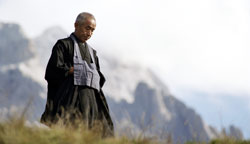I had a very moving interview with Kobun Sama that had and has a lasting influence. I told him about our way of shooting the bow, without a Kyudo bow and without the outer forms of the Kyudo tradition. I told him that we use other bows and that we quite consistently offer Zazen and the bow exercise as a ‘complete package’ in our house. There were many concerns about this practice from dogmatic Zen circles at that time. I was not sure if what we did was right in the sense of Zen. Kobun’s words were liberating and encouraging:
“Keep it up, do not let yourselves be swayed, it’s good what you’re doing!”
That was so clear, so present, without reservations, no diplomatic ciphers; it was simply pure Zen! So we went on and complemented our exercises with our experience of Indian archery, thus further developing our profile. The conversation with Kobun was an important encouragement on the way. We thank him!
If you are curious what has happened since then, visit our website at www.altbaeckersmuehle.de, or www.zen-bogenschiessen-altbaeckersmuehle.de
–Kurt KyuSei –
The goal of practice
By Jeff Brooks
Kobun Chino could divide a leaf of grass from a distance of 25 meters. His students were watching him doing that many times. On a spring day he drove with one of his students along the Pacific Coast Highway. He stopped the car on the roadside, opened the trunk and pulled out a two-meter-long Japanese bow and a quiver of hand-carved arrows. They walked across the street to the cliff, from which one could overlook the surging surf and the Pacific, infinite and extending to the horizon. The student would have seen the uniformly blue and cloudless sky over the Pacific, if he had looked up, but his gaze was fixed on the hands of his teacher, who placed the arrow masterfully on the bowstring and, with a slight inhalation, stretched the string to its maximum, his arms and back uniting with the bow, his eyes as sharp as the tip of the arrow.
The world froze for a moment. Then came the sound of the releasing arrow, exceeding the noise of the surf, followed by the ‘matsu kaze’, the pine wind, when the string of the bow came to a halt. The arrow flew in a high and gigantic arch over the ocean.
Kobun Chino was a Zen monk. He taught in a small center in Los Altos, as well as in Santa Cruz. Suzuki Roshi, the founder and leader of the San Francisco Zen Center, had invited him to come from Japan to the United States to help him develop the newly founded monastery of Tassajara. However, Kobun was not a friend of big institutions, he sought a simple and meditative life.
In the late 1960s Suzuki Roshi visited the small Zendo every Wednesday for some time. There he offered Dharma talks after the sitting. These talks were later published under the title ‘Zen Mind Beginner’s Mind’, which has remained one of the most influential Zen books.
For a moment the arrow disappeared before the eyes of the student, against the light of the Californian sky. It reappeared, such as a stroke of a pen against the blue, soared, began its long descent and eventually disappeared gracefully in the water. The men brought the bow and the empty quiver back into the trunk of their car and drove away. Today the student of this story is in his sixties. He recently related this episode of the day with his teacher 35 years ago in our small Zendo in New England in a winter night by candlelight.
Had a stranger or a novice seen this young monk shooting arrows out to the sea, he might have believed that the man had wasted the arrows. However, this student saw Kobun dividing a leaf of grass from a distance of 25 meters. This student knew Kobun as a lighthearted, but deeply serious man. And both knew that teachers have to teach. Even if they do not share a common language with each other, students and teachers do share their lives. Their intimate karmic connection sometimes can convey the essentials of life much better than any spoken word.
What was it that Kobun taught on that day? Can we say that Kobun gave his student a koan? Literally a koan is a public thing, an event that is passed on and subjected to testing and weighing. In China the term referred to a precedent, which was used to interpret the law. In the Zen tradition the koan is a public matter on the nature of ultimate reality, which relates to the subject of enlightenment.
Did Kobun want to say: ‘Only this moment’? Did he want to say to his student, a committed practitioner, ‘Only be concerned about the process, not the goal’? Maybe he wanted to express that in practice, such as in life, there is no specific goal; that, however well defined our goal may be, the trajectory of our thoughts goes to infinity, as well as the trajectory of our lives; that the only thing we really have is the point on the way on which we are right now; that the only course of action we can perform is the action we are engaged in right now. Maybe he just wanted to say ‘It is fun to shoot arrows into the sky and in the ocean.’
Metaphysical speculations cannot be of help here; only the direct insight into the nature of reality can free us from suffering, permanently and completely. Kobun Chino died while trying to save his five-year-old daughter from a pond. This illustrates the life of this great Zen teacher in a dramatic way. What he taught at that particular moment, so many years ago, inspired right here and now. It seems that his life continues to fly through space and time.






